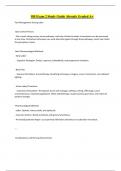OB Exam 2 Study Guide Already Graded A+
Pain Management During Labor
Gate Control Theory
- Pain travels along sensory nerve pathways, and only a limited number of sensations can be processed
at one time. Distraction techniques can send alternate signals through these pathways, which can inhibit
the perception of pain.
Non-Pharmacological Methods
- Early Labor:
- Cognitive Strategies: Doulas, hypnosis, biofeedback, and progressive relaxation.
- Back Pain:
- Sensory Stimulation: Aromatherapy, breathing techniques, imagery, music, focal points, and subdued
lighting.
- Active Labor/Transition:
- Cutaneous Stimulation: Therapeutic touch and massage, walking, rocking, effleurage, sacral
counterpressure, heat/cold application, TENS, hydrotherapy, acupressure/acupuncture, and maternal
position changes.
Pharmacological Methods
- Labor: Opioids, nitrous oxide, and epidurals.
- Cesarean Section: Spinal anesthesia and general anesthesia.
- Perineal/Episiotomy Repair: Local perineal infiltration anesthesia or pudendal nerve block.
---
Complications and Nursing Interventions
,IV Narcotics
- Complications: Cross the placenta, potentially causing neonatal respiratory depression.
- Intervention: Administer Narcan (naloxone).
Epidurals
- Complications: Maternal hypotension.
- Interventions:
- Ensure IV access and administer a fluid bolus.
- Continuously monitor blood pressure and fetal heart rate.
- Have oxygen and ephedrine available for emergencies.
Spinals
- Complications: Maternal hypotension and fetal bradycardia.
- Interventions:
- Administer a 500-1000 mL bolus of Lactated Ringer's or Normal Saline before placement.
- Evaluate fetal heart rate immediately after administration.
- Monitor respiratory rate and pulse oximetry every hour.
General Anesthesia
- Complications: Postoperative pain.
- Interventions:
- Set up a Patient-Controlled Analgesia (PCA) pump.
- Assess readiness for bonding with the baby.
- Place a wedge under the left hip during administration.
---
Induction and Augmentation of Labor
- Induction: Done for non-medical reasons, such as convenience, maternal fears, or discomfort.
, - Augmentation: Performed when labor has started spontaneously but is progressing unsatisfactorily.
Medications for Labor Induction
- Cytotec (Misoprostol): Used for cervical ripening, applied near the cervix; cannot be removed and may
cause uterine tachysystole.
- Cervidil (Dinoprostone): Used for cervical ripening, removable after 12 hours or when labor begins;
may also cause uterine tachysystole.
- Pitocin (Oxytocin): Stimulates uterine contractions; requires careful monitoring and consideration of
potential complications.
Assessment Readiness for Induction
- Bishop Score: Must score at least 8 to evaluate cervical readiness and predict labor success.
---
Infertility
- Common causes: Past cancers, irregular periods, smoking, drinking, history of STDs, age, and obesity.
- Testing Options:
- Women: Hormone testing, pelvic ultrasound, hysteroscopy, hysterosalpingography (least to most
invasive).
- Men: Semen analysis, physical exam, hormone testing (least to most invasive).
- Treatment Options: Medical therapy, assisted reproductive technology (ART), surrogacy, and adoption.
Assisted Reproductive Technology (ART)
- Includes In Vitro Fertilization (IVF) and Intrauterine Insemination (IUI).
- Medical Therapy: Clomid, progesterone, gonadotropins, FSH supplements, metformin.
Endometriosis
- Description: Tissue that normally lines the uterus grows outside it.
- Symptoms: Pelvic pain, dysmenorrhea, and painful intercourse.




